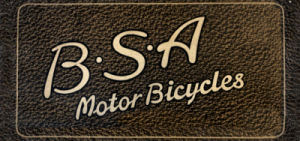


This machine is one of the most popular in the B.S.A. range for solo (and pillion) riding on account of its excellent road performance and very low running- costs. It is easy to handle, has a good road speed, and its four-stroke engine develops ample power to take the machine easily up any hill. Large tyres, spring seat saddle, and low riding position make the machine very comfortable to ride. The annual tax for the machine equipped to standard specification is only 30s.
Engine.
Single cylinder of 2.49 h.p. with bore and stroke of 63 x 80 mm. respectively, giving a cubic capacity of 249 c.c. Aluminium alloy piston and roller big-end bearing. The engine mainshaft on the driving side is mounted on ball bearing, and on plain bearing on gear side. Large special alloy steel valves. Silent timing gear, large bright plated exhaust pipe and silencer giving quiet exhaust without loss of efficiency.
Carburettor and Ignition.
Amac carburettor. A special carburettor fitted with an air cleaner can be supplied as an extra. Ignition by high tension magneto, driven by gears enclosed in oil-tight aluminium case.
Lubrication.
Gravity feed to mechanical pump, then to sight feed on timing case, and feeding to crankcase. A hand pump is also fitted for emergency use. Oil is supplied to the primary chains by depressing a spring by-pass valve on the sight feed. Grease-gun lubrication to the fork links, hubs, etc.
Transmission.
½ in. pitch roller chains are fitted throughout. The front drive is enclosed in a chain cases and the rear drive is protected by an efficient guard. A cam-faced cush drive is fitted to the engine shaft. Gear gear ratios see page 63.[1]
The floating dry-plate type clutch is contained in a large chain wheel, and is controlled by a lever on the left of the handlebar.
Gear-box.
Three-speed B.S.A. gear-box ; all the gears are constantly in mesh. The kick-starter mechanism, is enclosed in the gear-box. The change-speed lever is on the right side of the machine, and a selector quadrant is fixed on the gear-box so that the position of the lever can be readily seen. Screw adjustment of box position for accurately setting chain tension.
Frame and Forks.
The frame is specially designed to give low riding position and a low centre of gravity. It is constructed of pressed steel chainstays, weldless steel tubing and forged steel lugs throughout. A strong carrier is fitted. The spring forks are of B.S.A. type, fitted with a barrel-shaped compression spring and shock absorbers.
Handlebar and Tank.
Semi-sporting or touring handlebars can be fitted if specified ; both types are adjustable. The tank is tapered of rectangular section, and is rigidly attached to the frame. Filler caps, unleakable, secured with bayonet joint and chain. Capacity: petrol, 1½ gals. ; oil, 2¼ pints.
Wheels and Tyres.
The wheels have heavy gauge rims, 19 in. x 2¼ in., and 25 in. x 2.75 in. Dunlop cord wired-on tyres are fitted.
Brakes.
Both brakes are of the internal expanding type of 5½ in. diameter. The front brake is operated by a lever on the handlebar, and that at the rear by a toe pedal on an independent fulcrum on the right side of the machine. Grease-gun nipples are fitted to the cam spindles.
Saddle.
A Terry spring seat is standardized, but a Brooks supple seat can be supplied, if specified.
Mudguards.
Strong and wide of plain section.
Notes
1. More pages from this book are available at Craig Howell's Flickr pages. Craig Howell
Source: Book of the BSA by Waysider. Pitmans, 1928.